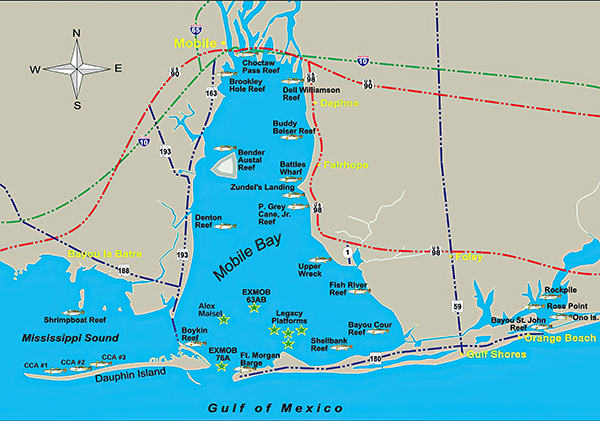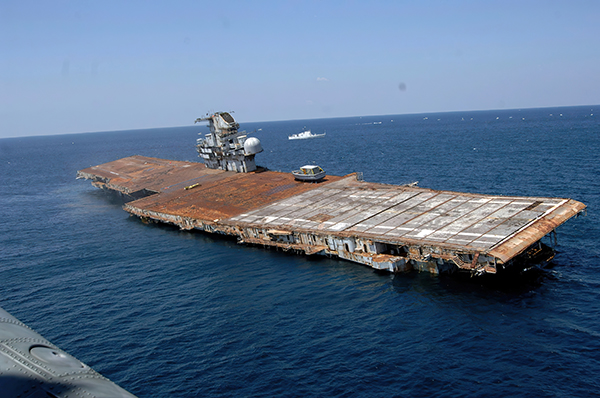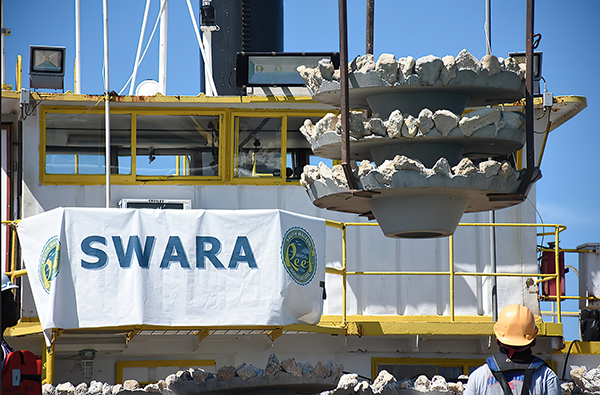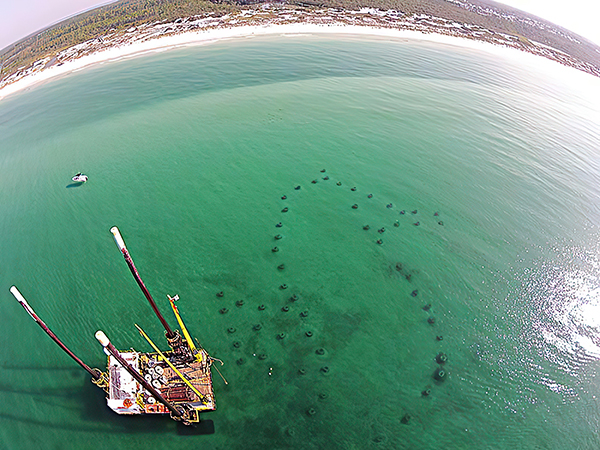To paraphrase the signature line in the Kevin Cosner movie, “Field of Dreams,” if you build an artificial reef, the fish will come. And it’s not a zero-sum game where they will move from one location to another. Creating new habitats increases the number of fish.
Alabama Creates the World’s Largest Open-Water Aquarium
When state boundaries were drawn, Alabama got seriously shortchanged on its Gulf of Mexico frontage. Compared to Florida, which has 1,350 miles fronting the Gulf of Mexico and the Atlantic, Alabama has a paltry 60-mile shoreline. To make matters worse, the natural seafloor from the beaches to 60 miles out is mostly a sandy, muddy desert, nearly devoid of habitat for fish, which isn’t great news for the anglers there. To remedy this, in 1953, local fishing guides from Orange Beach requested permission to dump 250 cars offshore to create more fish habitat. Their success spawned the initiative to allow private citizens to create artificial reefs, which was wildly successful. In 1997, the U. S. Army Corps of Engineers allowed an expansion to the area of Alabama’s artificial reefs. Now there are more than 17,000 in Alabama waters, spanning 1,260 square miles, with 95 percent built by private entities. In addition to offshore reefs, there are 21 inshore artificial reefs in Mobile Bay.

In contrast, Florida takes a more conservative approach and, with few exceptions, doesn’t allow private reefs. Despite its massive shoreline, it has 3,800 artificial reefs. How effective are these manufactured reefs at attracting fish? While Alabama only has about 1 percent of the Gulf of Mexico coastline as other states and countries, 40 percent of the recreational haul of red snapper is caught there.
Mistakes Were Made
At first, the rules for reef-building materials were pretty liberal, but lessons were learned the hard way. The Osborne Reef project was an ambitious program that employed two million discarded automobile tires to create a reef off Fort Lauderdale. At first, it seemed like a brilliant idea. Due to their durability, tires are an environmental problem in landfills and tire graveyards. Their shape also makes a perfect nursery for mosquitos due to the stagnant water that tends to accumulate within them. With great fanfare and the blessing of the U.S. Army Corp of Engineers, the project launched in 1974 when a symbolic golden tire was dropped from the Goodyear® blimp.
Unfortunately, the Osborne Reef became one of the worst marine ecological disasters in the United States’ history. The problem was the tires were bound together by steel clips and nylon ropes, which ultimately failed, leaving the tires to scatter during storms and hurricanes and smash into coral reefs and other living underwater habitats. They also wash up on shore, and their constant movement by currents inhibits new corals and plants from establishing themselves on the ocean floor. Despite the efforts to remove them, more than half a million remain. Legislation finally made it through the House and Senate committees, and a final plan for their removal is scheduled to be completed by July 2024...60 years after the ill-fated project began.

While Alabama still allows the building of private reefs, there are stricter rules regarding building materials. Cars haven’t been allowed for decades as they tend to move about during storms and have other issues related to the materials used. The wide diversity of materials used over the decades has provided scientists with valuable data on what materials are good and bad. For instance, P.V.C. pipes were used until it was discovered their surface was too slick to allow anything to grow on them, so now that’s forbidden. However, the state still encourages reef building, as evidenced by the reasonable $33 permit needed to get started before state officials scrutinize the project.

How to Make an Artificial Reef
The most popular reef-building material has been marine-friendly concrete mixed with Florida limestone. Shapes like hollow pyramids with holes are popular because they are storm-resistant and give smaller fish protection from predators. The concrete and rock combination is also an excellent surface to which algae, barnacles, oysters, and coral can attach themselves. These living appendages also attract smaller fish, which feed on them and use them to hide. A new method of building reef material comes from companies like Coastruction, which uses special 3D printers and computer modeling to construct objects made from stable materials that won’t harm the environment. The 3D process is fast and allows structures to be made with intricate shapes to maximize utility. The building of artificial reefs has attracted private investment from companies, and one of the largest is Walter Marine’s Reefmaker division, which has built and deployed more than 70,000 artificial reef structures since 1986.
Decommissioned ships are also commonly sunk to provide stable habitats for marine life. While Florida may have fewer reefs than Alabama, the ones they have tend to be larger, like the 911-foot aircraft carrier, U.S.S. Oriskany, nicknamed “The Great Carrier Reef,” which was sunk in 2006 off the coast of Pensacola. It’s not the only reef to use military hardware; in 1994, 100 M-60 tanks were splashed into Alabama waters.
Rigs to Reefs Program
While oil rigs can pose an ecological threat, they are also known as fish attractors, and their removal after their service life is over represents a loss of habitat. But starting in 1985, the U.S. Department of the Interior’s Bureau of Safety and Environmental Enforcement authorized the Rigs To Reefs program. To date, more than 600 oil rigs have been repurposed into reefs.
.jpg)
Coral Reefs Need Help
The world’s coral reefs are in jeopardy due to warming waters, acidification and pollution and need all the help they can get. In addition to creating new habitats, artificial reef structures can serve as the foundation for coral nurseries to help repopulate the ocean with these keystone animal colonies that are home to 25 percent of all marine species. Another benefit of artificial reefs is their published coordinates take pressure off smaller natural coral reefs, which can suffer damage from improper anchoring. According to studies, anglers are up to 10 times more likely to fish on artificial reefs, which gives fish populations in other areas a better chance to rebound and flourish.
While some environmental groups oppose artificial reefs, believing only natural objects belong on the seafloor, the tangible benefits seem to outweigh the negatives. Currently, 15 states have artificial reef programs and ongoing studies are underway that should reveal their overall effectiveness.
Back to Blue Life
Alabama Creates the World’s Largest Open-Water Aquarium
When state boundaries were drawn, Alabama got seriously shortchanged on its Gulf of Mexico frontage. Compared to Florida, which has 1,350 miles fronting the Gulf of Mexico and the Atlantic, Alabama has a paltry 60-mile shoreline. To make matters worse, the natural seafloor from the beaches to 60 miles out is mostly a sandy, muddy desert, nearly devoid of habitat for fish, which isn’t great news for the anglers there. To remedy this, in 1953, local fishing guides from Orange Beach requested permission to dump 250 cars offshore to create more fish habitat. Their success spawned the initiative to allow private citizens to create artificial reefs, which was wildly successful. In 1997, the U. S. Army Corps of Engineers allowed an expansion to the area of Alabama’s artificial reefs. Now there are more than 17,000 in Alabama waters, spanning 1,260 square miles, with 95 percent built by private entities. In addition to offshore reefs, there are 21 inshore artificial reefs in Mobile Bay.

In contrast, Florida takes a more conservative approach and, with few exceptions, doesn’t allow private reefs. Despite its massive shoreline, it has 3,800 artificial reefs. How effective are these manufactured reefs at attracting fish? While Alabama only has about 1 percent of the Gulf of Mexico coastline as other states and countries, 40 percent of the recreational haul of red snapper is caught there.
Mistakes Were Made
At first, the rules for reef-building materials were pretty liberal, but lessons were learned the hard way. The Osborne Reef project was an ambitious program that employed two million discarded automobile tires to create a reef off Fort Lauderdale. At first, it seemed like a brilliant idea. Due to their durability, tires are an environmental problem in landfills and tire graveyards. Their shape also makes a perfect nursery for mosquitos due to the stagnant water that tends to accumulate within them. With great fanfare and the blessing of the U.S. Army Corp of Engineers, the project launched in 1974 when a symbolic golden tire was dropped from the Goodyear® blimp.
Unfortunately, the Osborne Reef became one of the worst marine ecological disasters in the United States’ history. The problem was the tires were bound together by steel clips and nylon ropes, which ultimately failed, leaving the tires to scatter during storms and hurricanes and smash into coral reefs and other living underwater habitats. They also wash up on shore, and their constant movement by currents inhibits new corals and plants from establishing themselves on the ocean floor. Despite the efforts to remove them, more than half a million remain. Legislation finally made it through the House and Senate committees, and a final plan for their removal is scheduled to be completed by July 2024...60 years after the ill-fated project began.

While Alabama still allows the building of private reefs, there are stricter rules regarding building materials. Cars haven’t been allowed for decades as they tend to move about during storms and have other issues related to the materials used. The wide diversity of materials used over the decades has provided scientists with valuable data on what materials are good and bad. For instance, P.V.C. pipes were used until it was discovered their surface was too slick to allow anything to grow on them, so now that’s forbidden. However, the state still encourages reef building, as evidenced by the reasonable $33 permit needed to get started before state officials scrutinize the project.

How to Make an Artificial Reef
The most popular reef-building material has been marine-friendly concrete mixed with Florida limestone. Shapes like hollow pyramids with holes are popular because they are storm-resistant and give smaller fish protection from predators. The concrete and rock combination is also an excellent surface to which algae, barnacles, oysters, and coral can attach themselves. These living appendages also attract smaller fish, which feed on them and use them to hide. A new method of building reef material comes from companies like Coastruction, which uses special 3D printers and computer modeling to construct objects made from stable materials that won’t harm the environment. The 3D process is fast and allows structures to be made with intricate shapes to maximize utility. The building of artificial reefs has attracted private investment from companies, and one of the largest is Walter Marine’s Reefmaker division, which has built and deployed more than 70,000 artificial reef structures since 1986.
Decommissioned ships are also commonly sunk to provide stable habitats for marine life. While Florida may have fewer reefs than Alabama, the ones they have tend to be larger, like the 911-foot aircraft carrier, U.S.S. Oriskany, nicknamed “The Great Carrier Reef,” which was sunk in 2006 off the coast of Pensacola. It’s not the only reef to use military hardware; in 1994, 100 M-60 tanks were splashed into Alabama waters.
Rigs to Reefs Program
While oil rigs can pose an ecological threat, they are also known as fish attractors, and their removal after their service life is over represents a loss of habitat. But starting in 1985, the U.S. Department of the Interior’s Bureau of Safety and Environmental Enforcement authorized the Rigs To Reefs program. To date, more than 600 oil rigs have been repurposed into reefs.
.jpg)
Coral Reefs Need Help
The world’s coral reefs are in jeopardy due to warming waters, acidification and pollution and need all the help they can get. In addition to creating new habitats, artificial reef structures can serve as the foundation for coral nurseries to help repopulate the ocean with these keystone animal colonies that are home to 25 percent of all marine species. Another benefit of artificial reefs is their published coordinates take pressure off smaller natural coral reefs, which can suffer damage from improper anchoring. According to studies, anglers are up to 10 times more likely to fish on artificial reefs, which gives fish populations in other areas a better chance to rebound and flourish.
While some environmental groups oppose artificial reefs, believing only natural objects belong on the seafloor, the tangible benefits seem to outweigh the negatives. Currently, 15 states have artificial reef programs and ongoing studies are underway that should reveal their overall effectiveness.
Back to Blue Life
